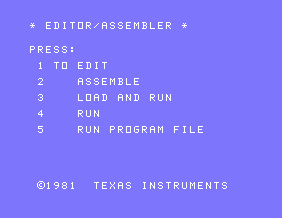Difference between revisions of "Editor/Assembler"
m |
|||
| Line 16: | Line 16: | ||
=== Load and Run === | === Load and Run === | ||
Loads one or more tagged files into memory, and allows the user to start a program. A tagged file is a machine language file which is relocatable, that is, it can be loaded into memory at (almost) any free location. This is quite comfortable when you have several modules to be loaded before the program can be started. | |||
If the file currently being loaded ends with an autostart tag, the system will execute that program. Otherwise the user gets a prompt for entering the name of the program to be started. | |||
=== Run === | === Run === | ||
Revision as of 18:40, 5 April 2011
The Editor/Assembler cartridge is one of the most important cartridges for the TI system. Together with the two companion floppy disks it provides an Integrated Development Environment (IDE) for assembly programming.
Overview
This is the start screen of the cartridge.
Menu selections
Editor
Enters the editor part of the E/A. When selecting LOAD or EDIT, the editor is loaded from the disk in drive 1. The editor's file name is EDIT1.
Assembler
Enters the assembler part of the E/A. First, the assembler must be loaded from the disk in drive 1. The assembler consists of the two files ASSM1 and ASSM2.
Load and Run
Loads one or more tagged files into memory, and allows the user to start a program. A tagged file is a machine language file which is relocatable, that is, it can be loaded into memory at (almost) any free location. This is quite comfortable when you have several modules to be loaded before the program can be started.
If the file currently being loaded ends with an autostart tag, the system will execute that program. Otherwise the user gets a prompt for entering the name of the program to be started.
Run
Any file that has been loaded by option 3 may be started by providing the program name here. This is the same functionality as in option 3, just without prior loading.
Run Program File
This option loads a memory image file or a set of files if the program is longer than 8 KiB. Execution starts immediatedly after loading the last file.
Loading memory images is particularly fast, but comes at the cost of flexibility. The program code is not relocatable anymore and must be previously saved as a memory image. Unlike programs loaded by option 3, memory images cannot rely on external utilities, so all required utilities must be included.
